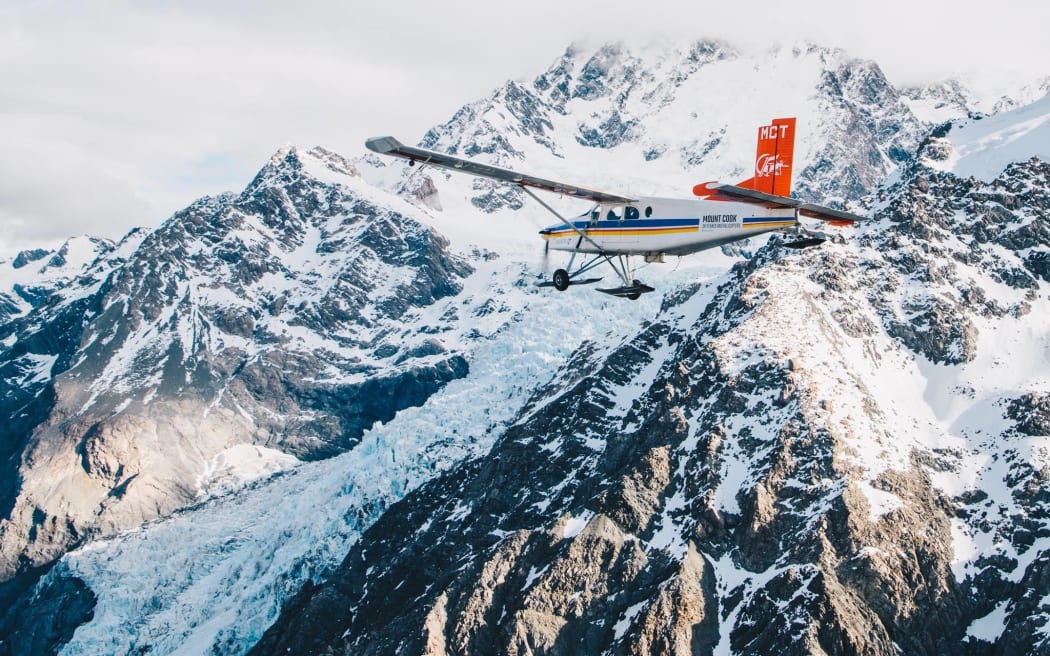
Kiwi pilot Sir Harry Wigley pulled off a daring landing on the Tasman Glacier in 1955, deploying homemade retractable skis below his Auster Aiglet plane to slide to a stop on the glittering mass of snow and ice.
It was the first ski-plane landing in the Southern Hemisphere.
Seventy years later, Mt Cook Ski Planes and Helicopters pilot Angus Ford said it was a thrill to follow in Wigley's snowy tracks.
"It is definitely challenging. You're landing on an uphill strip. You're essentially landing on the side of the mountain, it's quite exhilarating, at the best of times," he said.
The company founded by Wigley is the country's second-oldest airline after Air New Zealand and the only commercial ski-plane business in the Southern Hemisphere.
Each year hundreds of people take scenic flights on 10-seater Pilatus Porter planes with hydraulically-operated skis, to experience walking on a glacier.
"On a beautiful day on a nice bit of snow. It's absolutely incredible seeing their faces light up. It's the first time they've seen snow, a lot of them," Ford said.
INFLITE Tourism Group bought the company in 2015.

"Covid was a horrible time for any tourism business and I guess for us, it was just [about] getting back to our roots, really reshaping what we wanted the business to be, how we wanted to function," he said.
"We used the time to take our aircraft out of service, one by one, and put them through some really in-depth overhauls."

"It is really noticeable in an environment like that. We've heard stories from some of the older ski-plane pilots that they used to land at very different altitudes," he said.
In 2019, the company was the first national aviation tourism operator to achieve net zero carbon certification by making sure more flights were full, burning less fuel by idling and supporting projects to offset emissions.
Joyce said he expected the impacts of climate change to become more pronounced and the company would watch for emerging technology to leave a lighter environmental footprint.
"It's a really tough one, obviously we're very aware that we're burning a lot of jet fuel every day and that's a contributor," he said.
Leading Mt Cook Ski Planes and Helicopters into its eighth decade was a privilege, Joyce said.
"It's an absolutely remarkable achievement. We're really proud to be the caretakers of the business and still be offering the ski-plane and helicopter experiences up into the national parks," he said.

"I think it's an incredible story. You have your Bill Hamilton's with the jet boat around the same time, you've got the Gallaghers with the electric fences. There was so much innovation and problem solving around that post-war period in New Zealand, which I think is an incredible story and not many New Zealanders even know," he said.
"I like educating Kiwis on it, that we do have this industrious past. We did have these engineering capabilities way back in the 50s and 40s."
Wigley died in 1980 in Christchurch, survived by his wife and five children.
Joyce said the company planned to celebrate the 70th anniversary on 20 September, with free scenic flights for people who had contributed to the business, followed by a cocktail function for "telling all the old war stories".
Among those on the invite list was Tony Delaney, who first signed on in 1985 as an apprentice engineer, after working part-time refuelling planes during his school holidays.
He later became a station engineer and a commercial pilot.
Almost 40 years on, Delaney said the ski-planes still had not lost their magic.
"I think in the age of helicopters, retreating glaciers, you know, it's a real challenge. But to still see them, I still get a buzz when I'm standing on the snow and they come in. I quite often take videos. It's quite special," he said.














